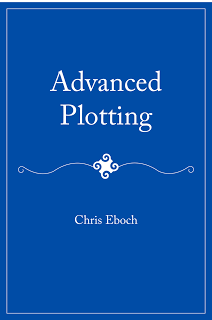Use Cliffhangers for Better Pacing
If you've been following this blog for a while, you'll know I love cliffhangers and think they're underused. I've written about them before, but it's time to revisit the topic. I have an essay on cliffhangers in my Advanced Plotting book, and I'm reprinting that here in three sections, for my regular Friday posts. I'll also be featuring guest authors from Advanced Plotting on Wednesdays. And of course, if you want the whole essay right now, you can get it in Advanced Plotting, along with lots of other good stuff to make your manuscripts stronger.
Hanging by the Fingernails: Cliffhangers
Several years ago I had the opportunity to ghostwrite a novel about a well-known girl sleuth. (You would recognize her name.) I knew the series used cliffhanger chapter endings. That seemed easy enough — find a dramatic moment and end the chapter.
Turns out writing strong cliffhangers is a little trickier than that. The editor responded to my effort with this comment: "I would like to see more of a slow build-up toward the intense action. In horror movies, it's always the ominous music and the main character slowly opening the closet door that scares us the most, not the moment right after she opens the door."
She's noting the difference between suspense and surprise.
When something happens suddenly and unexpectedly, that's a surprise. For example, if you are walking down the street debating where to have lunch and something falls off a window ledge onto your head, you'll be surprised (assuming you're still conscious). But since the surprise came out of nowhere, it wasn't suspenseful.
When writing we may be tempted to keep secrets and then let them out — bang! But suspense comes from suspecting that something will happen and worrying about it or anticipating it.
To build up truly dramatic cliffhanger chapter endings, give the reader clues that something bad — or excitingly good — is going to happen. Here's an example from Haunted: The Ghost on the Stairs, a novel for ages 8 to 12. The narrator, Jon, isn't sure he believes his little sister Tania when she says she can see ghosts, but goes with her to look for one as their stepfather films his ghost hunter TV show.
At the top of the stairs, my stepfather stood in the glare of a spotlight, a few feet away from a camera. I took a step backward and tugged at Tania's arm. No one had seen us yet, and we could still escape. Tania turned to me. The look in her eyes made my stomach flip.
The moment isn't bad for a cliffhanger chapter ending, but it could use some more buildup. Here's how the chapter ended in the published book:
At the top of the stairs, my stepfather stood in the glare of a spotlight, a few feet away from a camera. I took a step backward and tugged at Tania's arm. No one had seen us yet, and we could still escape. She didn't back up. She swayed. I took a quick step forward and put my arm around her so she wouldn't fall. I looked down into her face. I'd never seen anyone so white. White as death. Or white as a ghost. "Tania," I hissed. I gave her a shake. She took a quick breath and dragged her eyes away from the staircase and to my face. The look in them made my stomach flip.
The first thing you may notice is that the revised version is longer. To get the most out of dramatic moments, you actually slow the pace by using more detail. Focus on using sensory details with an emotional impact.
Next week: Powerful Paragraphing
 Advanced Plotting is designed for the intermediate and advanced writer: you've finished a few stories, read books and articles on writing, taken some classes, attended conferences. But you still struggle with plot, or suspect that your plotting needs work.
Advanced Plotting is designed for the intermediate and advanced writer: you've finished a few stories, read books and articles on writing, taken some classes, attended conferences. But you still struggle with plot, or suspect that your plotting needs work. Advanced Plotting can help.
Buy Advanced Plotting for $9.99 in paperback on Amazon or as a $2.99 e-book on Amazon or Smashwords.
Published on September 09, 2011 05:10
No comments have been added yet.



